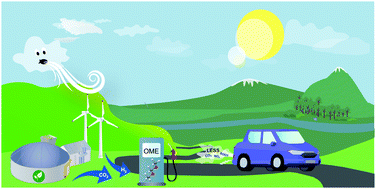当前位置:
X-MOL 学术
›
Energy Environ. Sci.
›
论文详情
Our official English website, www.x-mol.net, welcomes your feedback! (Note: you will need to create a separate account there.)
Cleaner production of cleaner fuels: wind-to-wheel – environmental assessment of CO2-based oxymethylene ether as a drop-in fuel†
Energy & Environmental Science ( IF 32.5 ) Pub Date : 2017-11-27 00:00:00 , DOI: 10.1039/c7ee01657c Sarah Deutz 1, 2, 3, 4 , Dominik Bongartz 2, 4, 5, 6 , Benedikt Heuser 2, 4, 6, 7 , Arne Kätelhön 1, 2, 3, 4 , Luisa Schulze Langenhorst 2, 4, 5, 6 , Ahmad Omari 2, 4, 6, 7 , Marius Walters 2, 4, 6, 7 , Jürgen Klankermayer 2, 4, 6, 8 , Walter Leitner 2, 4, 6, 8, 9 , Alexander Mitsos 2, 4, 5, 6 , Stefan Pischinger 2, 4, 6, 7 , André Bardow 1, 2, 3, 4
Energy & Environmental Science ( IF 32.5 ) Pub Date : 2017-11-27 00:00:00 , DOI: 10.1039/c7ee01657c Sarah Deutz 1, 2, 3, 4 , Dominik Bongartz 2, 4, 5, 6 , Benedikt Heuser 2, 4, 6, 7 , Arne Kätelhön 1, 2, 3, 4 , Luisa Schulze Langenhorst 2, 4, 5, 6 , Ahmad Omari 2, 4, 6, 7 , Marius Walters 2, 4, 6, 7 , Jürgen Klankermayer 2, 4, 6, 8 , Walter Leitner 2, 4, 6, 8, 9 , Alexander Mitsos 2, 4, 5, 6 , Stefan Pischinger 2, 4, 6, 7 , André Bardow 1, 2, 3, 4
Affiliation

|
The combustion of fossil fuels within the transportation sector is a key driver of global warming (GW) and leads to harmful emissions of nitrogen oxides (NOx) and particulates (soot). To reduce these negative impacts of the transportation sector, synthetic fuels are currently being developed, which are produced from renewable energy stored via catalytic conversion of hydrogen (H2) and carbon dioxide (CO2). A promising class of synthetic fuels are oxymethylene ethers (OMEs). This study conducts a prospective environmental assessment of an OME-based fuel using Life Cycle Assessment (LCA). We investigate an OME1-diesel-blend (OME1-blend), where OME1 replaces 24 mass% of diesel fuel. Such an OME1-blend could be a first step towards an OME transition. For the production of OME1 from CO2-based methanol, we consider both the established route via condensation with formaldehyde and a novel direct pathway based on catalytic combination with CO2 and hydrogen. To close the carbon loop, CO2 supply via biogas and direct air capture is considered. In a best-case scenario, hydrogen is produced by water electrolysis using electricity from wind power in the European Union as an input. The direct pathway reduces the required process steps from three to two and is shown to allow for an improved utilization of the energy provided by hydrogen: the exergy efficiency is increased from 74% to 86%. For combustion, we conducted experiments in a single cylinder engine to determine the full spectrum of engine-related emissions. The engine data provide the input for simulations of the cumulative raw emissions over the Worldwide Harmonized Light Vehicles Test Procedures (WLTP) cycle for a mid-size passenger vehicle. Our well-to-wheel LCA shows that OME1 has the potential to serve as an almost carbon-neutral blending component: replacing 24 mass% of diesel by OME1 could reduce the GW impact by 22% and the emissions of NOx and soot even by 43% and 75%, respectively. The key to achieving these benefits is the integration of renewable energy in hydrogen production. The cumulative energy demand (CED) over the life cycle is doubled compared to fossil diesel. With sufficient renewable electricity available, OME1-blends may serve as a promising first step towards a more sustainable transportation sector.
中文翻译:

清洁燃料的清洁生产:风力发电–用作替代燃料的基于CO 2的甲醛醚的环境评估†
运输部门中化石燃料的燃烧是全球变暖(GW)的主要动力,并导致有害排放的氮氧化物(NOx)和颗粒物(煤烟)。为了减少运输部门的这些负面影响,目前正在开发合成燃料,这些合成燃料是通过氢(H 2)和二氧化碳(CO 2)的催化转化而储存的可再生能源生产的。一类很有前途的合成燃料是甲醛醚(OMEs)。这项研究使用生命周期评估(LCA)对基于OME的燃料进行了前瞻性环境评估。我们研究OME 1-柴油混合(OME 1-混合),其中OME 1代替24质量%的柴油。这样的OME 1混合可能是迈向OME过渡的第一步。为了生产OME的1从CO 2基甲醇,我们考虑两个建立的路由通过与甲醛的缩合以及基于与CO催化组合的新颖的直接通路2和氢气。要关闭碳回路,可通过以下方式供应CO 2:沼气和直接空气捕获被考虑。在最理想的情况下,氢气是由水电解产生的,其中使用欧盟的风力发电作为输入。直接途径将所需的工艺步骤从三步减少到两步,并显示出可以改善对氢提供的能量的利用:放热效率从74%提高到86%。对于燃烧,我们在单缸发动机中进行了实验,以确定与发动机相关的排放物的全部光谱。发动机数据为模拟中型乘用车的全球统一轻型车测试程序(WLTP)周期内的累积原始排放提供了模拟输入。我们周密的LCA显示OME 1有潜力用作几乎碳中和的混合组分:用OME 1替代24质量%的柴油可以将对GW的影响减少22%,将NOx和烟灰的排放分别减少43%和75%。实现这些好处的关键是将可再生能源整合到制氢中。与化石柴油相比,生命周期内的累积能源需求(CED)翻了一番。有了足够的可再生电力,OME 1掺和物可能成为朝着更可持续的交通运输领域迈出的有希望的第一步。
更新日期:2017-11-27
中文翻译:

清洁燃料的清洁生产:风力发电–用作替代燃料的基于CO 2的甲醛醚的环境评估†
运输部门中化石燃料的燃烧是全球变暖(GW)的主要动力,并导致有害排放的氮氧化物(NOx)和颗粒物(煤烟)。为了减少运输部门的这些负面影响,目前正在开发合成燃料,这些合成燃料是通过氢(H 2)和二氧化碳(CO 2)的催化转化而储存的可再生能源生产的。一类很有前途的合成燃料是甲醛醚(OMEs)。这项研究使用生命周期评估(LCA)对基于OME的燃料进行了前瞻性环境评估。我们研究OME 1-柴油混合(OME 1-混合),其中OME 1代替24质量%的柴油。这样的OME 1混合可能是迈向OME过渡的第一步。为了生产OME的1从CO 2基甲醇,我们考虑两个建立的路由通过与甲醛的缩合以及基于与CO催化组合的新颖的直接通路2和氢气。要关闭碳回路,可通过以下方式供应CO 2:沼气和直接空气捕获被考虑。在最理想的情况下,氢气是由水电解产生的,其中使用欧盟的风力发电作为输入。直接途径将所需的工艺步骤从三步减少到两步,并显示出可以改善对氢提供的能量的利用:放热效率从74%提高到86%。对于燃烧,我们在单缸发动机中进行了实验,以确定与发动机相关的排放物的全部光谱。发动机数据为模拟中型乘用车的全球统一轻型车测试程序(WLTP)周期内的累积原始排放提供了模拟输入。我们周密的LCA显示OME 1有潜力用作几乎碳中和的混合组分:用OME 1替代24质量%的柴油可以将对GW的影响减少22%,将NOx和烟灰的排放分别减少43%和75%。实现这些好处的关键是将可再生能源整合到制氢中。与化石柴油相比,生命周期内的累积能源需求(CED)翻了一番。有了足够的可再生电力,OME 1掺和物可能成为朝着更可持续的交通运输领域迈出的有希望的第一步。


























 京公网安备 11010802027423号
京公网安备 11010802027423号